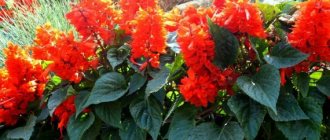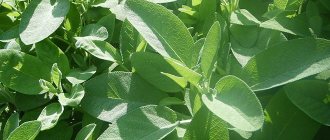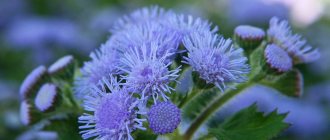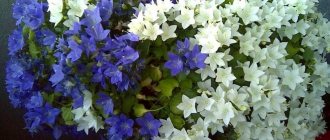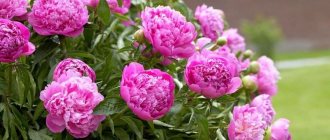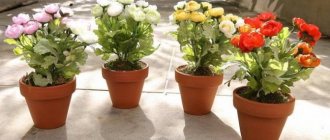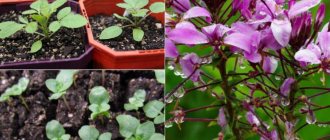History of selection
Sparkling sage (Salvia splendens) is also called shiny salvia. This is a cultivated perennial plant from the genus Sage (Salvia). Salvia was known back in ancient times - the first descriptions are found among the ancient Greek doctors Hippocrates and Dioscorides.
However, some species were discovered relatively recently. For example, the fortune teller sage (Salvia divinórum) became known only in 1962. This species was discovered by researchers Gordon Wassonche and Albert Hofmann, who went to the mountains of Mexico.
Subsequently, based on different types of sage, many varieties were bred for decorative use, including sparkling salvia. In nature, it is found in the tropical zone of Brazil. The plant is very heat-loving, so in cold climates it is grown mainly as an annual flower.
Salvia sparkling prefers warm, sunny places and does not tolerate severe frosts.
Description of Salvia sparkling and characteristics
Sparkling sage is a perennial flowering shrub. Densely covered with leaves arranged oppositely (opposite each other). They are ovoid in shape, veins are visible on the surface, and grow on petioles. The edge of the leaf blades of Salvia sparkling is solid, the size is medium (2–3 cm wide). The outer side is a rich green color, the underside is lighter.
The shape of the sparkling salvia bush is reverse pyramidal. The plant is compact and does not grow wide, so sage is usually planted densely, with an interval of 15–25 cm. The root system of the sparkling salvia is very powerful and well branched. The bush confidently occupies space and receives moisture and nutrients from the soil.
The flowers of sparkling salvia are large, irregularly shaped, with a double perianth. They are collected in large inflorescences-tassels, their length is 15–25 cm. Each of them contains many small flowers - from 30 to 90. Often pubescence appears on the peduncles of the same color as the petals. The color is predominantly bright red, although there are other colors (depending on the variety of sparkling sage):
- white;
- pink;
- coral;
- purple.
Flowering continues for a very long time - from mid-June to early October (ends with the onset of the first frost). Salvia brilliantis adorns the garden all season long. Flower growers also appreciate this plant for its low maintenance requirements.
Fruits – 4 nuts with seeds. They can be collected and stored for 3–5 years. If the variety is varietal, it is easy to grow at home (sowing seeds for seedlings). If it is a hybrid, then it is not advisable to collect seed material: it will not produce flowers. Therefore, seeds should be purchased from stores or suppliers.
Height of Salvia lucidum
Salvia brilliantis (pictured) is a low, compact bush, reaching a height of 20 to 70–80 cm. The culture is used to decorate any flower bed, create a lush flower carpet or frame a path.
Sparkling sage fits harmoniously into any flower garden
Features of care
Growing
You need to care for this flower in the same way as most others. It needs to be weeded, watered, fed in a timely manner, and the soil surface must be loosened. Watering should be done only when the soil is completely dry and always in the evening. Remember that you should not pour a large amount of water, because if the liquid stagnates in the soil, the root system of salvia can easily rot. After the water is absorbed into the soil, its surface must be loosened, and at the same time weeds must be removed. During the season, this plant needs to be fed with complex mineral fertilizer at least 2 times. It is necessary to feed the plants with a weak nutrient solution when they are still in the house in boxes. The second time this procedure is carried out during budding.
Perennial salvia is somewhat more difficult to care for than annual or biennial salvia, which are sown with seeds before winter. The thing is that these plants need formative pruning. It will protect the shoots from being pulled out and exposed, and the plant will also become bushier, as young stems will actively begin to grow. At the end of flowering, do not forget to remove all faded flowers from the salvia. Before wintering or at the beginning of the next period of intensive growth, the bush will need to be trimmed. To do this, you need to remove the old stems that have become woody, so that only a few centimeters with buds and young greens remain.
Diseases and pests
This plant is resistant to almost all types of diseases. However, harmful insects such as thrips, mites, whiteflies, aphids, as well as snails and slugs that eat salvia leaves can settle on it.
You can get rid of slugs and snails by picking them up with your hands. To do this, you can lay out pieces of slate or rags between the plants, and then systematically collect pests hiding under cover during the daytime. You can also make traps. To do this, you need to place several saucers filled with fruit juice or beer on the site. Slugs, like snails, love these drinks and crawl away, attracted by their aroma; all you have to do is collect them. Make special umbrellas that can protect the saucers from precipitation and debris.
To kill other harmful insects, you will need appropriate insecticides.
Salvia after flowering
The flowering of such a plant begins in June, and when it ends depends directly on the species (sometimes only with the onset of the first frost). There are species that bloom twice a year. For example, when the flowering of forest salvia ends, it is recommended to cut off its shoots completely; in this case, at the end of the summer period, the bush will bloom again, especially if fertilizers are added to the soil. After such a perennial plant has finished blooming completely, it needs to be cut off, and then sprinkle the surface of the soil with a layer of mulch (garden compost), paying special attention to the growing points. In this case, salvia will be prepared even for severe winter frosts. For greater reliability, it is also recommended to cover young bushes with dried leaves or spruce branches.
Varieties of Salvia shiny
There are more than 10 varieties of sparkling sage, which are successfully used to decorate the garden. The most popular varieties are Karabiner, Scarlet, Dwarf mix and others.
Carabinieri
Salvia sparkling Carabiner is a low-growing shrub (up to 25–30 cm) with bright red flowers. A herbaceous plant with a tetrahedral stem and tubular inflorescences. This variety of sage is used in dense plantings (the interval between plants is 20 cm) - in ridges, in flower beds, and for decorating borders.
Read more Perennial sage (salvia): description, photo of flowers, sowing, care The Karabiner variety attracts attention with bright inflorescences
Scarlet
Salvia sparkling Scarlet is a relatively tall bush, quickly growing up to 60 cm. It is characterized by a long flowering period, tolerance to drought and short-term cold snaps, and other unfavorable conditions. Plants are used to decorate paths, planted in flower beds and garden beds. They can also be grown in flower pots.
In the photo of the Salvia sparkling Scarlet flower, you can see that the flowers are painted in a coral, light red hue.
Red flowers look harmonious against the background of rich green foliage.
Dwarf mix
Salvia sparkling Dwarf mix is a low-growing, densely leafy shrub (up to 25 cm) with numerous inflorescences of various colors:
- bright red;
- purple;
- lilac;
- orange;
- white.
Flowering begins in the second half of July and continues until autumn (until the onset of the first frost). Looks very impressive in any planting. The culture is used in mixborders, front flower beds and borders. It is recommended to plant such sage quite densely - with an interval of 20–25 cm. In this case, the seedlings are transferred to open ground only in early June, since the plant is heat-loving.
Important! This variety of sparkling salvia prefers fertile and light soils.
If the soil is clayey, when digging, add coarse sand 200–300 g per 1 m2.
The brilliant sage variety Dwarf mix produces lush flowers of various colors
Dwarf ed
Salvia sparkling Dwarf red is a small, compact bush that grows up to 30 cm. It is densely covered with leaves and has lush panicle inflorescences of bright red color. The number of buds is very large, so sage looks attractive.
Salvia Dwarf red is usually used to frame paths, borders, as well as in borders and main flower beds in the garden.
Bonfire
Salvia sparkling Bonfire (bonfire) is a densely leafy bush that grows up to 60 cm by mid-summer. It produces many lush racemose inflorescences of bright red color. When planted tightly, it looks like a “bonfire”, which is how the variety got its name.
Flowering of the variety Koster is abundant and long - from mid-June to the end of September
Salvia Charm cherry
Salvia sparkling Charm cherry
- compact bush. Grows up to 30 cm. The flowers are a delicate cherry color, which is how the variety got its name. The racemose inflorescences are very large - 15–25 cm long. Flowering lasts all summer and part of autumn, if the season is warm - until October. Used to decorate ridges and ceremonial flower beds. This variety of shiny sage looks especially beautiful against the backdrop of well-groomed lawns.
Cherry salvia decorates the garden with attractive flowers for 3-4 months in a row.
Fire of Prometheus
Another variety of sparkling sage is Prometheus's Fire (Salvia splendens St. John's Fire). This is a small, graceful bush, reaching a height of 20–30 cm (sometimes up to 15 cm). The flowers are beautiful, neat, red. They enliven the space and decorate even inconspicuous corners in the garden. Flowering is very long - until the first frost.
The Prometheus Fire variety can be used not only in the garden, but also for growing at home
Splendes Pink
The Splendens pink variety of sparkling sage is very popular for its attractive pink and soft lilac flowers that appear from the first half of July until October. The bushes are small, compact, grow up to 30 cm. Densely covered with rather large bright green leaves. Salvia sparkling pink loves sun and good moisture, so it needs regular watering.
Lush flowers of Salvia Pink look spectacular against the backdrop of large bright green leaves.
Vesuvius
This variety of sparkling crop is distinguished by lush panicle inflorescences of bright red color and large leaves up to 9 cm wide and up to 10 cm long. The bushes are compact, quite tall - up to 45–50 cm.
Read more Perennial sage (salvia): description, photo of flowers, sowing, care
The shiny salvia variety Vesuvius begins to bloom later than everyone else - in early August
Planting salvia in the ground
It is better to choose light, permeable soil with plenty of sand for sowing salvia. It should also contain lime and humus.
Almost all salvias love sunny places. Only a few varieties can grow in partial shade (for example, Salvia adhesive). The place should be sheltered from the wind.
Seedlings are transplanted into open ground after the threat of night frosts has passed. As a rule, in the south it is May, in the central part of Russia it is mid-May, in the northern regions it is early June.
Salvia bushes are planted in small holes at a distance of 25-30 cm from each other. It is advisable to first add a handful of humus to each hole.
Features of care
In hot summers, salvias need abundant watering; the rest of the time they need a small amount of water. It is best to use a drip system. It is advisable to carry out the procedure in the evening.
The next day after watering, it is recommended to loosen the soil. Feeding is usually carried out twice per season. This is done during the period of growing seedlings and at the time of bud formation.
Growing perennial salvia is somewhat more difficult. It requires pruning and shaping the bush. This is done to stimulate the growth of new shoots.
Typically, mass flowering begins as early as June, and continues until frost in the autumn months.
But different types of this plant have their own characteristics of flower formation. For some, flowers form twice per season. This is what characterizes Salvia sylvestris. After it finishes its first bloom, its stems are cut back and after they regrow, flowers appear again in late summer. It is recommended to feed this plant with fertilizers.
@Graeme Jones, Flickr
Wintering perennial salvia
Before the winter cold, the stems are cut so that 10-12 centimeters remain above the ground, the lower leaves are removed.
In the northern regions, perennial salvia should be dug out of the ground with the onset of cold weather and stored in a bright room in boxes with soil. The temperature must be above 0ºC.
Reproduction methods
Sparkling salvia can be propagated by seeds and cuttings. The first case is more labor-intensive, but by growing seedlings yourself, you can speed up the start of flowering. It is easier to propagate a sparkling plant using cuttings. In this case, the offspring will retain all the characteristics of the mother bush.
Propagation by seeds
Seedlings are grown from Salvia sparkling seeds. They should be sown in February or no later than the first days of March. The soil can be used either store-bought or your own. Initially, sparkling salvia seeds are planted in common containers, and then planted in individual pots.
At the first stages, seedlings are grown in greenhouse conditions (moisturized abundantly, covered with film), then at room temperature. Salvia sparkling is transferred to open ground at the end of May or at the beginning of June. In the south, work can be carried out 2-3 weeks earlier.
Propagation by cuttings
It is better to propagate sparkling green salvia by cuttings at the end of summer, when the plant is sufficiently strong and the main wave of flowering has already passed. Sequencing:
- Select several shoots and cut cuttings 10–15 cm long.
- Place in a container with water, cover from direct sunlight.
- After a few days, inspect the seed: if any leaves of the brilliant sage begin to fade, they need to be removed completely or partially.
- 2 weeks after receiving the cuttings they give roots. At this point, they can be transplanted to a permanent place or into a pot.
- In the first days, it is advisable to shade the plants from the sun, regularly water and spray them. In the future, care is standard, as for an adult salvia.
When to plant salvia
From sowing seeds to flowering – 3-4 months. Currently, there are also hybrid varieties on sale that bloom earlier. Read the packaging!
For seedlings
Usually, seeds are sown to obtain seedlings from the second half of February to the beginning of April. Then you can get flowering already at the beginning of summer.
Directly into the ground
Salvia is planted with seeds directly into open ground no earlier than May.
Before winter
Perennial salvia is sown in the fall, before frost.
Sage is planted in the ground when the threat of frost has passed - it is important to take this into account. The plant is afraid of frosts below 3-5ºC.
When to plant salvia according to the lunar calendar 2022
To get strong seedlings and well-flowering salvia, it is useful to stick to certain days for planting seeds, and then seedlings in the ground.
Favorable days to plant salvia seeds in 2022:
| Month | Better days | Month | Better days |
| January | 23-27 | April | 3-7, 12-15, 21, 22 |
| February | 4-14, 17-23 | May | 2-5, 12-14, 18-25 |
| March | 3-16, 20-21 | June | 1-3, 6-13 |
The following days are identified as the most favorable for planting seedlings in open ground:
- May – 2-5, 12-14, 18-25
- June – 1-3, 6-13
In 2022, unfavorable days fall on the following dates:
- January – 2, 3, 17, 18
- February – 1, 2, 16, 28
- March – 1, 2, 18, 27, 28
- April – 1, 2, 16, 23
- May – 1, 16, 30
- June -14, 18, 29
- July – 13, 14, 28, 29
- August – 11, 12, 27-28
- September: 9-10, 26, 27
- October: 9, 10, 25, 26
- November: 1, 2, 7-9, 24, 25, 28, 29
- December: 7-9, 23-25
How to grow and care for salvia sparkling
In the climatic conditions of Russia, sparkling salvia is obtained from seedlings so that the flowering time occurs in the summer. To do this, you should determine the sowing time in advance, prepare the seed and ensure normal conditions for growing.
Sowing time
Salvia sparkling seeds are planted in February, since the plant begins to bloom 2.5-3 months after the appearance of the first shoots. The specific period depends on the climatic characteristics of the region:
- In the middle zone, seeds are planted in mid-February.
- In the Urals, Siberia and the North-West - in early March.
- In the southern regions - in early February.
Soil and seed preparation
For growing sparkling salvia seedlings, universal soil, which can be purchased at the store, is suitable. You can also make the mixture yourself using garden or forest soil with coarse sand and peat (in equal quantities). An alternative option is compost, peat and coarse sand (1:1:0.5). The soil should first be disinfected - for example, keep it in the oven for 15–20 minutes at a temperature of 150 degrees or put it in the freezer for several days.
You can make your own shining sage seeds by collecting them and saving them from last season, or you can purchase them at the store. Before planting, they are placed on gauze moistened with a weak solution of potassium permanganate (1%), then kept for several hours in a stimulator (Epin, Zircon, aloe juice with water in equal quantities).
Sowing Salvia shiny seeds and caring for seedlings
Instructions for planting Salvia sparkling seeds:
- A layer of small stones is placed at the bottom of the box or container.
- Fill up the soil.
- Water generously or spray with a spray bottle.
- Take a small pinch of seeds (they are very small) and scatter them over the surface.
- Lightly press them inwards - it is not necessary to sprinkle them with soil.
- Cover the container with film with holes or glass and place in a warm place (25–26 degrees).
Read more Perennial sage (salvia): description, photo of flowers, sowing, care
Salvia sparkling seedlings need to be pruned after two or three pairs of leaves appear
Important! If there is a lack of sunlight, be sure to organize illumination with a phytolamp until the total daylight hours are 14–15 hours.
Periodically, the greenhouse with sparkling salvia seeds is ventilated and moistened, and accumulated water is removed from the surface of the lid. As soon as 2-3 pairs of leaves appear, seedlings are planted in individual containers; plastic glasses are suitable. The shoots must be removed very carefully so as not to damage the roots.
After transplantation, sparkling sage seedlings are fed with complex fertilizer. They can be grown in moderately warm conditions - temperature 21–23 °C.
Planting in open ground and subsequent care
Salvia prefers well-lit places, but light shading is also allowed. The planting site should be located on a hill, and not in a lowland where rain moisture accumulates. In this case, the soil should be quite fertile. If the soil is depleted, humus or rotted manure should be added when digging - 2–5 kg per 1 m2.
Planting Salvia sparkling is easy. Dig several shallow holes at a distance of 15–30 cm from each other (depending on the variety and design features), lay a layer of small stones, root the seedling and cover it with fertile soil. Then water and mulch abundantly.
Further care:
- Watering as needed (once every 10 days in the absence of rain).
- At the stage of bud formation, they are fed with complex fertilizer.
- After the end of the first wave of flowering, the peduncles of sparkling salvia are cut off.
- The soil is periodically loosened and weeded if necessary.
- To keep the soil moist longer, it is mulched with humus, peat, sawdust or other material.
For lush flowering, sparkling salvia needs to be fed once in mid-June.
Growing seedlings
Growing salvia is not difficult. Taking into account its tropical origin, this must be done through seedlings, otherwise the garden will not bloom.
Salvia seedlings
At the end of February, the seeds are sown in planting boxes, the bottom of which is covered with a layer of drainage material. The substrate for salvia is light and nutritious. It is easy to prepare it yourself in the following composition: bee bread, garden soil, sand (1: 2: 1). The soil is poured into the container not reaching a couple of cm to the top edge.
Advice. Salvia seeds are small and practically invisible against the background of the soil. Therefore, for ease of sowing, it is better to mix them with sand or dust them with chalk.
After uniform distribution on the surface of the moistened substrate, the seeds are pressed by hand, the boxes are covered with transparent material and left in a warm place until germination.
The sprouts appear unfriendly, after half a month, after which the cover is removed, and the container with the sprouted plants is placed in a well-lit, warm place. It is advisable to provide the seedlings with lighting so that daylight hours last at least 12 hours. Seedlings should be watered moderately, as the soil dries, with melted or well-settled water.
Attention! You should not water salvia seedlings frequently and abundantly. Excess moisture in containers leads to rotting of the base of the shoots.
After two leaves appear on the young plants, the seedlings are planted. To do this, water the soil with the grown salvias well, then carefully remove one sprout at a time with a sharp tool. The lower part of the root is pinched off a few mm, so it will develop better.
Flowerbed with salvia
In order for the plant to begin to branch and the bush to become lush, it is recommended to pinch the top after three pairs of leaves have formed.
Pests and diseases
Salvia sparkling can suffer from the following diseases: blackleg, fusarium, root rot, late blight.
In summer, bushes can be parasitized by various pests, including aphids and thrips. As a preventative measure, monitor the watering rate, and also treat salvia seedlings with fungicides after transplanting into the ground. For this you can use any drugs:
- "Skor";
- "Ordan";
- "Fitosporin";
- "Maksim";
- "Fundazol" and others.
Insecticides will help destroy insects:
- "Aktara";
- "Fitoverm";
- "Green Soap";
- "Decis";
- "Confidor".
Salvia sparkling is processed late in the evening, in dry and windless weather.
Application in landscape design
Salvia sparkling looks good in the garden - both in front flower beds and in remote areas. This flower is often used in mixborders, to design paths, zoning a flower garden, near the entrance, gazebo and other centers of attraction.
Below are several options for using sparkling sage in landscape design:
- For decorating paths.
- For decoration of nondescript places in the garden.
- Landing near the house.
- Sparkling sage in combination with other ornamental plants.
- In the central flowerbed in the garden.
- Single planting of brilliant sage.
- Sparkling salvia in a flowerpot.
